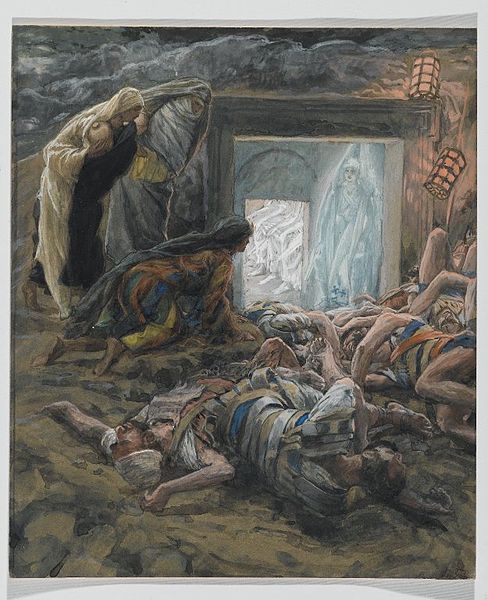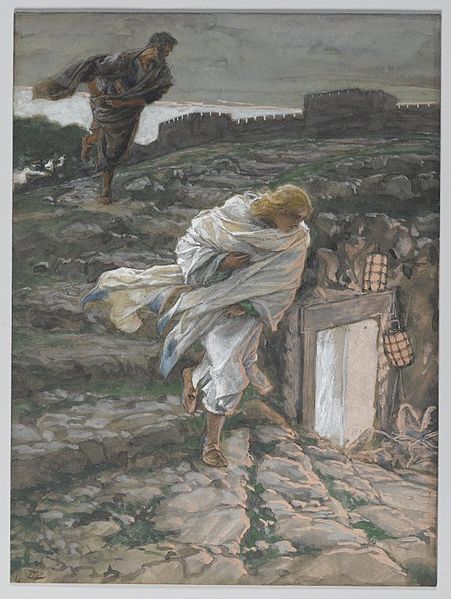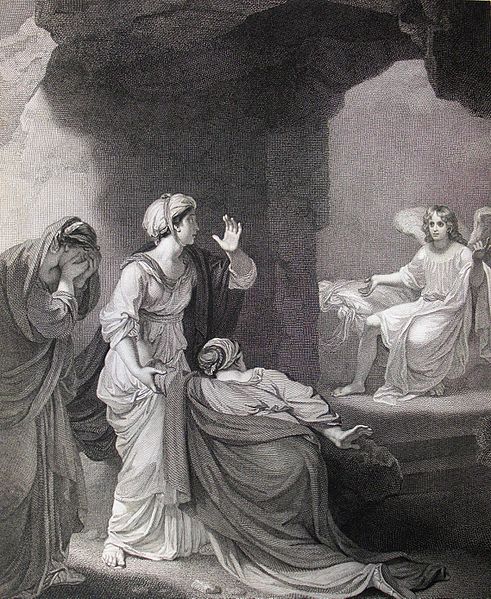Scripture readings: Acts 10:34-43; Ps. 118:1-2,14-24; 1 Cor. 15:1-11; John 20:1-18 Sermon by Ted Johnston (from John 20:1-18) Drawing on commentary by Warren Wiersbe (Bible Expository Commentary), Donald Guthrie (New Bible Commentary), Michael Card (The Parable of Joy), and F.F. Bruce (The Gospel of John).
The Dawning of the New Day
Here is a video from GCI Media that would make a good call to worship for this Easter Sunday service.On Vimeo at https://vimeo.com/257629649.
Introduction
Biographies usually end with the subject’s death. But the book of John is gospel, not mere biography. It proclaims the good news of Jesus’ life, death, burial and resurrection. John’s purpose in writing is to invite us to believe—to place our trust in the resurrected God-man, Jesus—God’s own Son. A central focus of the Gospel of John is the reality of Jesus’ resurrection. Why? Because the resurrection is the best evidence that Jesus is God’s Son, our Savior. The empty cross and the empty tomb affirm that our debt has been paid, that Jesus is alive, and that we are now alive in him! Glory to God!

(public domain via Wikimedia Commons)
Jesus’ enemies tried to conceal the fact of Jesus’ resurrection. The Jewish religious leaders claimed his body had been stolen by Jesus’ followers. But that can’t be true—the tomb was sealed and guarded by soldiers. Others claimed that Jesus’ disciples had visions of the risen Lord and interpreted them as evidence for the resurrection. But that theory does not hold up—Jesus’ disciples did not believe what Jesus said in predicting his resurrection. Their mindset was not the kind of psychological preparation from which hallucinations are made. Moreover, how could the 500+ people (who Paul says, in 1 Corinthians 15:6, saw the resurrected Jesus) have the same hallucination at the same time?
Others claim that Jesus did not die, but only swooned and later was revived. This argument does not hold up either—many witnesses testified that Jesus was dead when his body was taken down from the cross. Later, he was seen alive by dependable witnesses.
The only logical conclusion is that Jesus kept his promise and rose from the dead, though that glorious truth was not understood immediately, even by Jesus’ closest followers. It gradually dawned on these grieving people that their Master was not dead, but alive! And what a difference it made when the full realization took hold! For most of them, it meant going from fear to courage. For Mary Magdalene it meant a three-stage journey of unfolding faith: 1) faith eclipsed, 2) faith dawning, and 3) faith shining. Let’s travel that journey with her today. It’s one that involves John and Peter as well.
1. Faith eclipsed (John 20:1–2)
Early on the first day of the week, while it was still dark, Mary Magdalene went to the tomb and saw that the stone had been removed from the entrance. So she came running to Simon Peter and the other disciple, the one Jesus loved, and said, “They have taken the Lord out of the tomb, and we don’t know where they have put him!” (John 20:1-2)
Out of their love for Christ, Mary Magdalene and some other women went to the tomb early Sunday morning to complete the burial preparations. Joseph of Arimathea and Nicodemus had been forced by circumstances to prepare Jesus’ body hastily, and these women wanted to finish the task. Their great concern was how to get into the tomb. Perhaps the Roman soldiers would take pity and help them.

by Tissot (public domain via Wikimedia Commons)
What the women didn’t know was that, before arriving, an earthquake had occurred and the stone sealing the tomb had been rolled back by an angel. It seems Mary Magdalene got to the tomb first. Seeing that it was open, she concluded that somebody had broken in and had stolen Jesus’ body. It’s understandable that she reached that conclusion—it was still dark, she was alone, and like the other followers of Jesus, she was not expecting him to return from the dead.
Mary ran to give the news Peter and John. It’s significant that the first witnesses of Jesus’ resurrection were women. Among the Jews of that day, the testimony of women was not held in high regard. “It is better that the words of the Law be burned,” said the rabbis, “than be delivered to a woman.” But these women had a greater message than that of the Law, for they knew that their Savior, the fulfillment of the Law, was alive.
What ever faith Mary had up to this point was a mere shadow of what was now emerging. Peter and John were in the same spiritual condition, but soon all three would move out of the shadows into the light.
2. Faith Dawning (John 20:3–10)
So Peter and the other disciple started for the tomb. Both were running, but the other disciple outran Peter and reached the tomb first. He bent over and looked in at the strips of linen lying there but did not go in. Then Simon Peter, who was behind him, arrived and went into the tomb. He saw the strips of linen lying there, as well as the burial cloth that had been around Jesus’ head. The cloth was folded up by itself, separate from the linen. Finally the other disciple, who had reached the tomb first, also went inside. He saw and believed. (They still did not understand from Scripture that Jesus had to rise from the dead.) Then the disciples went back to their homes…. (John 20:3-10)
Apparently Peter headed out first, running to the tomb, but John arrived first. Both deserve credit for having the courage to run into enemy territory, not knowing what lay ahead. The whole thing might have been a trap to catch the disciples. When John arrived, he cautiously remained outside (perhaps waiting for Peter), though he was able to peer in. What did John see? The grave clothes lying on the stone shelf without any evidence of violence or crime. But the clothes were empty!

Peter arrived and impulsively went into the tomb. He too saw the linen clothes lying there empty and the cloth for Jesus’ head carefully folded and lying by itself. Grave robbers do not carefully unwrap the corpse and then leave the grave clothes neatly behind. With the presence of the spices in the burial wrappings, it would be almost impossible to unwrap a corpse without damaging them. The only way the clothes could be left in that condition would be if Jesus passed through them as he rose from the dead. Entering the tomb and looking at the evidence, John “saw, and believed.”
In writing this paragraph, John used three different Greek words that all mean seeing. In verse 5 the word translated “look in” means to glace. In verse 6, the word translated “saw” means to look carefully. In verse 8 the world translated “saw” means “to perceive with intelligent comprehension.” There is a progression of understanding implied here—the resurrection faith of these witnesses was dawning!
What kind of faith did Peter and John have at this stage of their spiritual experience? It was faith based on evidence. They could see the grave clothes; they knew that the body of Jesus was not there. However, as good as such evidence is to convince the mind, it can never change the life.
Those of us who live centuries later cannot examine that evidence like Peter and John did. But we do have the record of these eye-witnesses in Scripture, and John confirms in John 20-21 that the record is true.
For the disciples, the Word of God was what we call the Old Testament. Those Scriptures foresaw the resurrection of Jesus in multiple ways. As recorded in Matthew 12, Jesus used the book of Jonah to illustrate his resurrection. The apostle Paul, in 1 Corinthians 15, saw in Israel’s Feast of Firstfruits a picture of Jesus’ resurrection. There are many other examples.
After his resurrection, Jesus revealed himself to only selected witnesses who would then share the good news with others. That witness is found in the New Testament; and both the Old and New Testaments agree in this witness to the fact that Jesus Christ is alive!
Peter and John saw the evidence and believed. Later, the Holy Spirit confirmed their faith through the Old Testament Scriptures. That evening, they would meet the Master personally! Faith that had been in the shadows, now started to emerge, and the light will get even brighter.
3. Faith Shining (John 20:11–18)
Mary stood outside the tomb crying. As she wept, she bent over to look into the tomb and saw two angels in white, seated where Jesus’ body had been, one at the head and the other at the foot. They asked her, “Woman, why are you crying?” “They have taken my Lord away,” she said, “and I don’t know where they have put him.” At this, she turned around and saw Jesus standing there, but she did not realize that it was Jesus. “Woman,” he said, “Why are you crying? Who is it you are looking for?” Thinking he was the gardener, she said, “Sir, if you have carried him away, tell me where you have put him, and I will get him.” Jesus said to her, “Mary.” She turned toward him and cried out in Aramaic, “Rabboni!” (which means Teacher). Jesus said, “Do not hold on to me, for I have not yet returned to the Father. Go instead to my brothers and tell them, ‘I am returning to my Father and your Father, to my God and your God.'” Mary Magdalene went to the disciples with the news: “I have seen the Lord!” And she told them that he had said these things to her. (John 20:11-18)
Mary Magdalene deeply loved Jesus and came early to the garden to express that love. Peter and John had gone home by the time Mary got back to the tomb, so they did not convey to her the conclusion they had reached from the evidence they had examined. Mary still thought Jesus was dead, and her weeping at the tomb was the loud lamentation characteristic of Jews in mourning.

Looking into the tomb, Mary saw two men dressed in white. Their position at either end of the shelf where the body had been lying reminds us of the cherubim overshadowing with their wings the mercy seat in the Temple. It is as though God is saying, “There is now a new mercy seat! By dying and rising from the dead, my Son has opened the way into my presence!” Mary was not disturbed at seeing these men—she apparently did not know they were angels. The brief conversation with them neither dried her tears nor quieted her heart. She was still determined to find the body of Jesus.
Why did Mary not continue her conversation with the two strangers? Did she hear a sound behind her? Or did the angels stand and recognize the presence of their Lord? In any case, she now knew that the Lord’s body was not in the tomb, so why linger there? And why did she not recognize the one for whom she was earnestly searching? Jesus aparrently concealed himself. Also, it was still early and perhaps dark in that part of the garden. Her eyes were probably blinded by her tears.
Jesus asked Mary Magdalene the same question that the angels had asked, “Why are you crying?” He then added, “Who is it you are looking for?” Jesus knew that Mary’s heart was broken and that her mind was confused. He did not rebuke her. Instead, he tenderly revealed himself to her. All he had to do was speak her name, and Mary immediately recognized him. As John wrote in chapter 10, the sheep recognize the shepherd’s voice as he calls them by name. What a blessed surprise to see the face of her beloved Master!
All Mary could say was, “Rabboni—my Master, my Teacher.” “Rabbi” and “Rabboni” were equivalent terms of respect. Mary not only spoke to him but grasped Jesus’ feet and held on. This was a natural gesture: now that she had found him, she did not want to lose him. She and the other believers still had a great deal to learn about Jesus’ new state as a glorified human being—they still wanted to relate to him as they had during the years of his ministry before the cross.
Matthew’s account tells us that Jesus permitted the other women to hold his feet as well, so why say to Mary, “Do not hold on to me”? One reason was that she would see him again because he had not yet ascended. He remained on earth for 40 days after his resurrection and often appeared to the believers during that time to teach them. Mary had no need to panic—this was not her last and final meeting with the Lord. A second reason is that she had a job to do—to go tell Jesus’ “brothers” that he was alive and would ascend to the Father.
Before this, Jesus had called his followers “servants” and “friends,” but now he calls them “brothers.” This meant that they shared his resurrection power and glory. He reminded Mary and the other believers that God was their Father and that he would be with the Father in heaven after his ascension. In his upper room message on Maundy Thursday evening, he had taught them that he would return to the Father so that the Spirit might come to them.
It would have been selfish and disobedient for Mary to have clung to Jesus and kept him to herself. She arose and went to where the other disciples were gathered and gave them the good news that she had seen Jesus alive. Mark’s account says these believers were mourning and weeping—and that they would not believe. Unbelief has a terribly deadening effect.
Mary not only shared the fact of Jesus’ resurrection and that she had seen him personally, but she also reported the words that he had spoken to her. Again, we see the importance of the Word of God. Mary could not transfer her experience over to them, but she could share the Word. As Paul tells us in Romans 10, it is the Word that generates faith.
Conclusion
What a blessing to learn of Jesus, the living Word of God, in the story recorded in the written word of God. But it is one thing to accept a teaching and something else to have a personal encounter with the risen Lord. Peter and John believed the testimony that Jesus was alive, but it was not until they encountered Jesus personally that true and lasting faith emerged.
Dear ones, today, on Easter Sunday, we are reminded of the powerful, transforming truth that Jesus is risen from the dead! He is alive forevermore! I invite you to believe that truth and in believing to encounter the risen Lord.
[Note to preacher: here would be a good time to extend to the audience an invitation to receive Christ as their personal Lord and Savior, perhaps inviting those who do so to gather after the service for prayer and counsel concerning their next steps.]



Please note that comments are moderated. Your comment will not appear until it is reviewed.